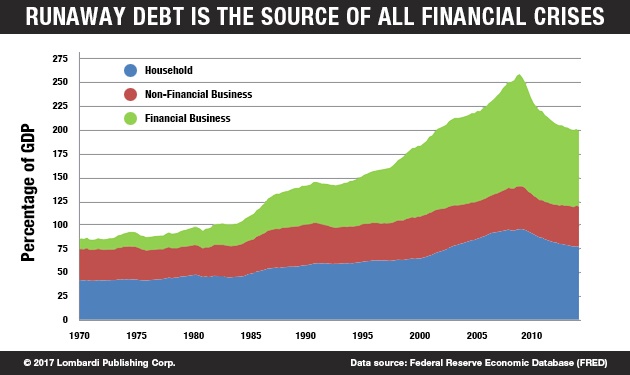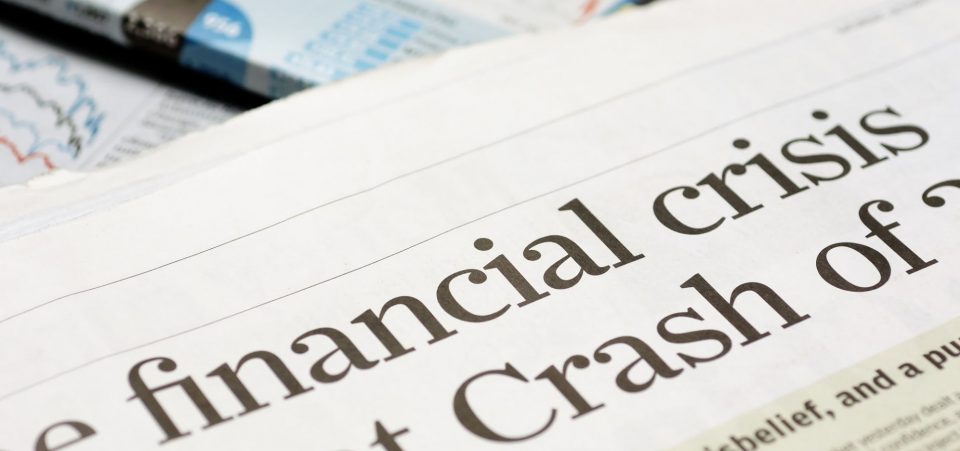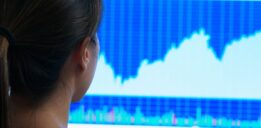When Will the Next Financial Crisis Happen?
Since the Berlin Wall came down, the world has not experienced the end of history, as Francis Fukuyama arrogantly proclaimed. Rather, sovereign states have seen the rise of globalization—that is, the suppression of the sovereign state by the economy in the form of the markets. The 2008 financial crisis has been one of the effects of this phenomenon.
Is it any wonder that politics—ever more unrecognizable from economics—promotes the one percent? That’s why people should heed the next financial crisis prediction. The billionaires have gotten more billions in the past nine years, but nothing has changed. The one percent, the global elite that is the product of globalization, has not suffered during the Great Recession. Thus, they have gone on doing exactly the same things that led to the Lehman Brothers Holdings, Inc. implosion in 2008.
Nouriel Roubini, the man who predicted the 2008 financial crisis, fears that Wall Street has ignored the negative impact of President Donald Trump’s agenda. In fact, Roubini, whose bearish—and eerily correct—predictions have earned him the nickname “Dr. Doom,” says it could happen again. He agrees with those who expect the next financial crisis in 2017.
Analyst’s Dire Warning About the Next Financial Crisis 2017
Roubini simply believes that President Trump and his policies have reached the top of the list of threats to the world economy. Trump, says Roubini, is the world’s biggest risk. Roubini has given Trump a semi-failing grade for his first 100 days. And that was the most generous comment the famous economist and professor from NYU had for President Trump. (Source: “Dr. Doom: Trump is the biggest risk in the world,” CNN, May 2, 2017.)
Roubini hints that a financial crisis in 2017 is likely. He argues that the Trump administration’s economic, foreign, and security policies have confused the markets. This has fueled global uncertainty, because the United States is the world’s largest economy. Thus, the consequences of a severe policy error could be enormous.
Wall Street does not seem to be very concerned about Roubini and the possibility of an imminent stock market crash. Trump’s pledges to reduce tax rates, undo regulations, and spend on infrastructure have helped propel the S&P 500 well over 11% since his election. But that is precisely why investors should be on high alert. The risk of a bubble is high, based on the Shiller PE ratio.

The markets are overestimating the positive and underestimating the negative, said Roubini. (Source: Ibid.)
Remember that the global financial crisis of 2008, which Roubini foresaw in 2006, began in the United States. It spread across the globe in real time and it damaged economies physically and financially distant from Wall Street itself.
Is There Another Financial Crisis Coming?
President Trump’s expectations that the United States’ GDP might grow at around three percent seems overly optimistic. Indeed, growth has slowed down everywhere, even in China, this year. Roubini pointed to several specific risks coming from the Trump White House. The president’s protectionist policies could trigger a trade war.
Moreover, closing borders to goods and people makes it difficult for companies in the U.S. to attract talent from abroad. Many of the people, who have sustained the American entrepreneurial and innovative spirit, especially in Silicon Valley, were immigrants. Meanwhile, Trump’s dramatic fiscal cuts have one sure effect: they will increase U.S. debt.
Indeed, Trump’s fiscal plan, which Roubini called a “joke,” could increase the U.S. inequality problem. Roubini, a major skeptic of the “drip distribution” economy, pointed out how important tax cuts did not help boost the economy or the workers under the administration of President George W. Bush. The tax cuts will benefit the rich and corporations by a large degree. The middle classes and the poor won’t see many, if any, benefits at all.
When Roubini starts delivering gloomy predictions, investors should pay attention. Had investors paid attention to his warnings in 2006, they would have gotten out of the markets well in time to maximize returns ahead of the 2008 financial crisis and the associated Great Recession.
Many don’t know that on September 7, 2006, Roubini, a professor of New York University, addressed a group of his senior colleagues at the International Monetary Fund (IMF). He warned them that a nightmare scenario was unfolding. That nightmare scenario was the crisis that would happen two years later.
The 2008 Financial Crisis of 2008 Went Something Like This
As Roubini predicted, it involved the explosion of the real estate bubble amid hugely inflated oil prices. The result was an inevitable and severe recession. As you can imagine, in 2006, experts ignored Roubini’s predictions. After all, the markets were roaring. Well, almost exactly two years later after Roubini’s “Cassandra” moment, the perfect storm of financial clouds rained on Wall Street’s parade, shutting it down. Lehman Brothers collapsed on September 15, 2008.
In fact, what Roubini foresaw has roots in the summer of 2007. That’s when the first clouds from the U.S. subprime mortgage bubble appeared. As a reminder, the subprime mortgages are “second division” real estate mortgages. Banks gave young couples or families with an average, or below average, income mortgages. Since lending to these categories requires a higher risk for lenders, subprime usually requires a higher interest rate.
Still, between 2001 and 2004, a large number of less-than-solvent Americans bought houses after signing contracts of this type at a very low cost and a variable rate. Besides, in the post-September 11, 2011 rally, subprime interest rates went as far down as one percent or thereabouts. The banks were not so worried by the risk of owners defaulting. The housing boom inflated real estate values and household debt. Thus, the banks expected to expropriate and auction properties in cases of insolvency.

But, interest rates rose starting in 2003. Many subprime borrowers found themselves unable to make the mortgage payments. This forced the banks to actuate their Plan B. They foreclosed homes to recover what money they could squeeze. This triggered a vicious circle. As banks kept foreclosing houses, they also started to flood the market, then in decline, with homes.
This excess of homes for sale forced prices down by as much as 30%. Meanwhile, oil prices started to increase, and by 2007, they were exceeding over $100.00 per barrel. Raw materials followed suit. That was just the beginning of the crisis, or its prelude. Gradually, the deflating real estate bubble prompted investors to lose confidence. The markets followed suit, culminating in smaller banks and financial institutions going bust.
The apex of that phase came as Lehman Brothers went bust in September 2008. The reason this historic investment bank erupted is because it had purchased an inordinate amount of subprime-based derivatives. These were collateralized debt obligations (CDO) and structured investment vehicles (SIVs) based on the subprime mortgage debt.
They were supposed to attract investors with very high returns. But the mechanisms upon which derivatives are based are so complex that they can deceive amateurs and experts, such as large institutional investors. The rating agencies like Standard and Poor’s or Fitch Ratings awarded these subprime derivatives generous ratings. This allowed them to become popular.
Few Understood How Toxic the Derivatives Were
Thus, literally, the derivatives fell like a house of cards and brought down the whole global financial system. The widespread diffusion of the derivatives fueled uncertainty and accelerated the 2008 financial market crisis. This, in turn, spread its toxicity to the entire U.S. and global real economy. Just as in 1929, Wall Street developed a disease that spread to Main Street.
To overcome the lack of liquidity (i.e. the availability of money) caused by the many defaults (bankruptcies) of banks and lenders, governments and central banks around the world started pumping billions in the banking system—the infamous Bailout of Wall Street—to prevent a banking crisis. Now, Roubini did not predict all this in 2006.
But, he didn’t have to get all the details straight. He had enough of a hunch from what he could observe to expect a crash. He understood the financial environment as ready for a crash. He just could not predict the black swan that would trigger it. In that sense, the black swan—an event which can only be identified after the fact—was the Lehman Brothers collapse.
The financial environment is ready for a financial crisis in 2017. We don’t know what could prompt it, but the conditions are ripe. Last year, the biggest concern was a “hard landing” in China, which could have triggered a domino effect, bringing down the rest of the world with it. In 2015, the collapse of the eurozone seemed imminent. Frankly, both those things are still possible, but the uncertainty that Trump’s administration is generating has the potential of generating triggers everywhere at any time.
There is Brexit. Theresa May has announced that the U.K.’s divorce from Europe won’t be easy. But the British position is far more fragile than what Downing Street believes. The EU has presented a huge bill for Britain’s departure, which suggests it’s easier to join the European club than to leave it. Still, the French elections have left a divided France. And other populists are also driving the effort to break Europe in pieces.
The collapse of the eurozone only takes one European member state to pull out. The breakup of the eurozone would hit global markets hard. That’s because the euphoria linked to Donald Trump’s electoral victory has pushed the markets to unrealistic levels. Once the realities of Europe come face to face with an ever more patent ineffectiveness by the Trump administration, a market crash is all but assured.
In the midst of all this, Trump has not reduced political risk; he has increased it to levels not seen since the 1980s. Therefore, volatility indicators are rising amid a fragile financial environment.






